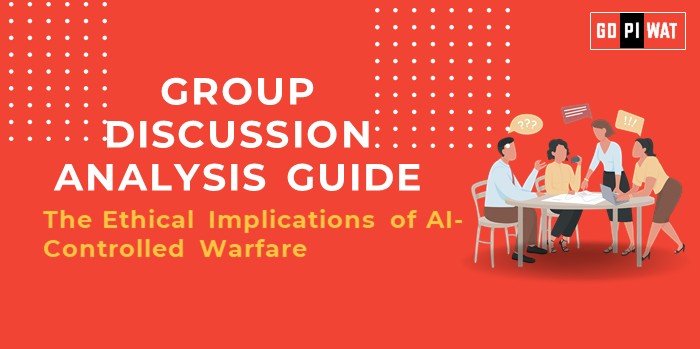📋 Group Discussion (GD) Analysis Guide: The Ethical Implications of AI-Controlled Warfare
🌐 Introduction
AI-controlled warfare, with its promise of precision and reduced human involvement, represents a paradigm shift in modern military strategy. However, it also raises significant ethical and practical concerns, particularly in distinguishing combatants from non-combatants and ensuring accountability.
📊 Quick Facts & Key Statistics
• Global AI in Defense Spending: Valued at USD 9.31 billion in 2024, with a projected CAGR of 13% from 2025 to 2030.
• Civilian Risks: AI’s lack of nuanced judgment raises concerns about potential civilian casualties.
• Countries Investing in AI Weapons: The United States and China lead in AI-driven military applications such as autonomous drones.
• United Nations Stance: Since 2013, progress on regulating lethal autonomous weapons has been slow due to member state disagreements.
• Civilian Risks: AI’s lack of nuanced judgment raises concerns about potential civilian casualties.
• Countries Investing in AI Weapons: The United States and China lead in AI-driven military applications such as autonomous drones.
• United Nations Stance: Since 2013, progress on regulating lethal autonomous weapons has been slow due to member state disagreements.
🌟 Stakeholders and Their Roles
- 🏛️ Governments: Funding and deploying AI-enabled military technologies.
- 💻 Private Tech Firms: Innovating and supplying AI systems to defense sectors.
- 🌍 International Organizations: Advocating for regulatory frameworks to control autonomous weaponry.
- 🗣️ Civil Societies: Highlighting ethical concerns and lobbying for humanitarian guidelines.
🏆 Achievements and Challenges
📌 Achievements:
- ✅ Precision and Efficiency: AI enhances targeting accuracy and operational efficiency.
- ✅ Reduced Human Risk: Decreases battlefield exposure for soldiers.
📌 Challenges:
- ⚠️ Ethical Dilemmas: Delegation of life-and-death decisions to machines raises moral questions.
- ⚠️ Civilian Casualties: Risks due to system errors or misidentifications.
- ⚠️ Global Regulation: Lack of consensus hampers effective international treaties.
🎯 Effective Discussion Approaches
- Opening Approaches:
- “AI-controlled weapons revolutionize warfare but pose critical ethical challenges in ensuring civilian safety.”
- “The race for AI militarization raises pressing questions about global security and moral responsibility.”
- Counter-Argument Handling:
- Acknowledge benefits like operational efficiency while emphasizing the need for ethical safeguards and accountability mechanisms.
📈 Strategic Analysis of Strengths & Weaknesses
- Strengths: Enhanced operational precision, reduced human exposure, and strategic superiority.
- Weaknesses: System errors, ethical dilemmas, and lack of transparency.
- Opportunities: Global treaties for safe AI use, establishment of AI ethics councils.
- Threats: Escalating arms races, misuse by rogue states or groups.
🗣️ Structured Arguments for Discussion
- 👍 Supporting Stance: “AI-controlled systems offer unprecedented operational advantages in modern warfare.”
- 👎 Opposing Stance: “The ethical risks and potential for civilian harm outweigh the benefits of deploying AI in warfare.”
- ⚖️ Balanced Perspective: “AI’s role in warfare should be accompanied by stringent international oversight and ethical considerations.”
🎓 Connecting with B-School Applications
- Real-World Applications:
- Defense ethics consultancy.
- AI technology management and governance.
- Sample Interview Questions:
- “What mechanisms can ensure ethical AI deployment in military applications?”
- “Discuss the challenges of global consensus on AI warfare regulation.”
- Insights for Students: Analyze ethical implications in strategic decision-making and technology governance.


